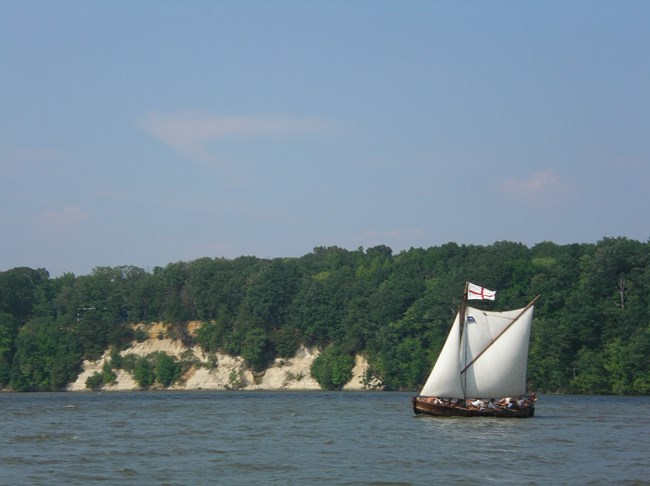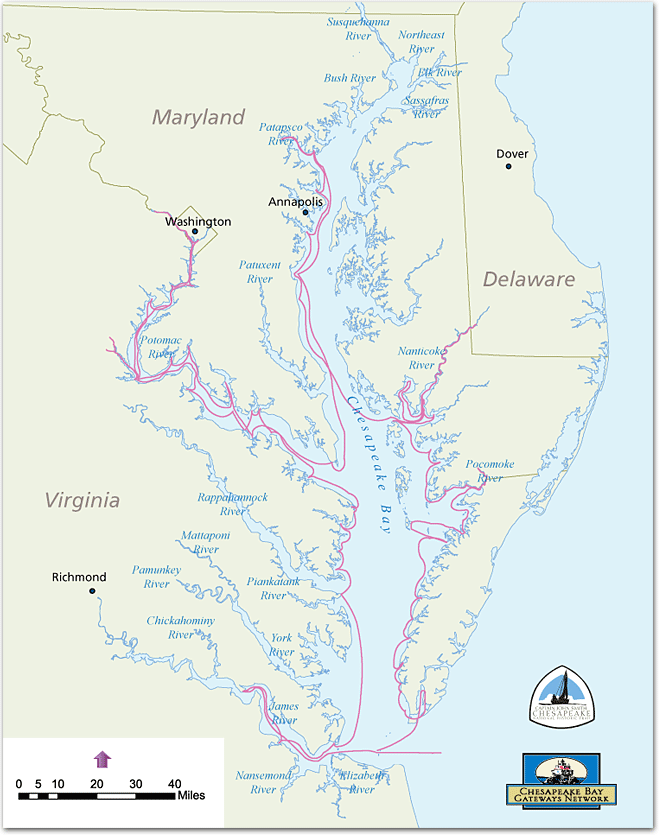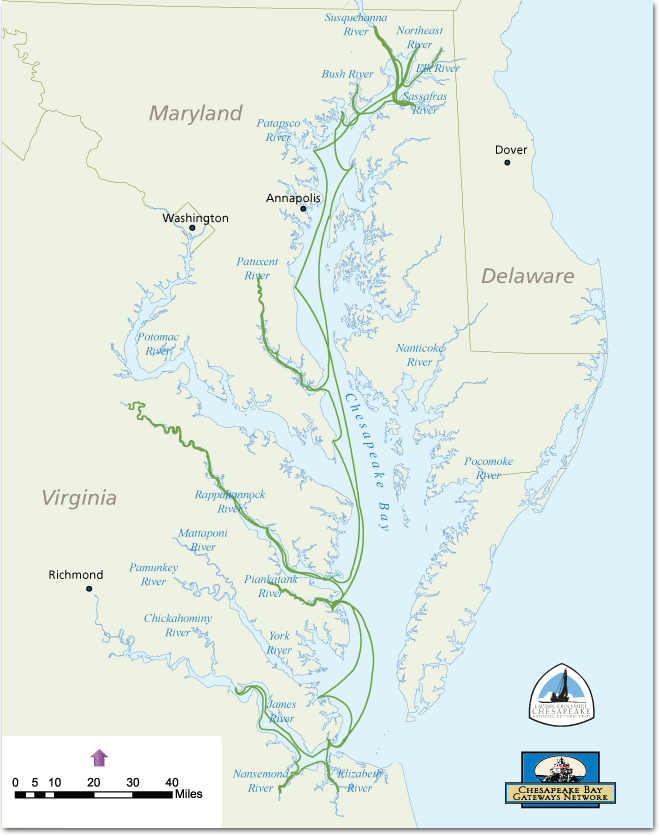Last updated: December 15, 2023
Article
A Closer Look: John Smith's Chesapeake Voyages

Chris Cerino
In 1607, the Virginia Company of London funded a group of 106 to venture across the Atlantic and form a colony. They landed here, in the Chesapeake Bay, and established a settlement they called Jamestown after King James.
The British came to the Chesapeake in hopes of finding gold and silver. In addition, unaware of just how large the North American continent was, they searched for a water passage to the Pacific Ocean. Such a passage would allow them to reach China to trade without needing to sail around Africa. This fabled route was known as the Northwest Passage. If the English discovered any of these riches, they might be able to compete with the Spanish, who had become wealthy and powerful by conquering territory throughout Central and South America.
So, when Captain John Smith – a member of the Jamestown colony – voyaged throughout the Chesapeake Bay, his primary goals were to discover precious metals and the Northwest Passage. He also set about mapping the area, learning about Indigenous peoples, and claiming land for the English crown. As we now know, the Chesapeake Bay was neither rich in gold nor a passageway to the Pacific Ocean. Rather, the Virginia Colony would not become profitable to the English until it began growing desirable strains of tobacco a few decades later. But when John Smith set out in the summer of 1608, he did not know what fortune might await him in the winding rivers of the estuary.
That summer, Captain John Smith set out on two exploratory voyages that covered thousands of miles of the Chesapeake Bay and its tributaries. The information he recorded about Indigenous peoples and the landscape introduced the region to those in England hoping to expand the colony. Later in his life, he documented the region he named New England in a similar fashion. Helping to attract settlers to the colonies, Smith’s explorations had consequences for Indigenous peoples who would soon face displacement and violence as they resisted colonial intrusion.
Smith’s voyages resulted in primary sources, including a map of the Chesapeake Bay and journals that he later expanded on in his 1624 book The Generall Historie of Virginia, New-England, and the Summer Isles. Published in the aftermath of Opechancanough’s deadly raid on Jamestown and other nearby settlements, the publication of The Generall Historie was partly Smith’s effort to maintain support for the Virginia colony in England.

NPS
First Voyage: June 2 to July 21, 1608
Captain John Smith led 14 men on his first voyage. Setting off from Jamestown, the crew headed north along today's Eastern Shore. They then moved to the Western Shore to probe the rivers now known as the Patapsco, Potomac, and Rappahannock, before returning to Jamestown.
The crew encountered Native people nearly every day. Although the appearance of a European ship would have been unexpected, by this time Indigenous people living in the Chesapeake would not have been ignorant of Europeans. Tribes to the north had already traded with the French and Dutch, and the Spanish had ventured into the Chesapeake decades before. The meetings between Indigenous peoples and Smith were mostly friendly, and many towns were willing to share food and water with the crew. Some Tribes, however, did not choose to welcome the Englishmen and drove them away.
It is worth noting that Smith’s actions went against the agreement he made the previous winter with the paramount chief Powhatan. We cannot be sure if Smith was fully aware of this or not. However, at that time, Powhatan considered Smith a subordinate. Smith therefore would have required Powhatan’s permission before interacting with outside Tribes.
As they sailed into foreign waters, the crew’s biggest danger was uncertainty. Unsure of where their next drink of water would come from, the expedition also had to cope with dangerous storms. On one occasion, Smith wrote that "the winde and waters so much increased with thunder, lighting, and raine, that our mast and sayle brew overbord and such mighty waves overracked us in that small barge that with great labour we kept her from sinking by freeing out the water."With the end of the voyage in sight, Smith was almost killed by a stingray. However, he survived and reported eating the ray for supper. His sense of humor expressed itself again when he transformed his vessel to look like a Spanish ship to frighten his fellow colonists.
Captain: John Smith
Doctor: Walter Russell
Gentlemen (familiar with firearms): James Bourne, William Cantrill, Richard Fetherstone, Thomas Momford, Ralph Morton, Michael Sicklemore
Carpenter (boat repair): Robert Small
Blacksmith: James Read
Fish Merchant (knew edible fish): Richard Keale
Fisherman/Sailor: Jonas Profit
Laborer/Soldier: James Watkins
Soldier: Anas Todkill
Tailor (clothes and canvas for sails): John Powell
June 2: John Smith and his crew depart Jamestown towed by the Pheonix, a supply ship on its way back to England.
June 3: On the lower Eastern Shore, Smith meets with the weroance, or chief, of the Accomack. He asks him a few questions about what he might find to the north.
June 4: Sailing north along the shore, a thunderstorm strikes, and "with great danger we escaped the unmerciful raging of that ovean-like water."
June 5: Rowing around Watts and Tangier islands, the crew runs short on water. Smith says, "we would have refused two barricoes of gold for one of that puddle water." They rest for the night in the town of Wighcocomoco.
June 6-7: The crew continues exploring along the Eastern Shore. Another storm tears the sail and breaks the mast, which require repair.
June 8-10: At Roaring Point, the local people attempt to repel the English with archers waiting on the shore. The next evening, Smith comes ashore and leaves a basket of trade goods. Eventually, four Nanticoke men unaware of the situation meet with Smith and spread the word that he does not wish to attack. Hundreds of people come down the river to talk and trade with the English. It’s possible he meets with the tallak, or paramount chief.
June 11 - 16: Departing the Nanticoke, Smith crosses the Bay to travel along the Western Shore. He is eager to find the Massawomecks, who the Nanticoke had told him about, thinking that their position to the northwest might mean they have knowledge of a passage to the Pacific Ocean. He explores the Patapsco River, finding no human habitation in the area. Low on food, the crew grows weary.
June 15-16: The shallop returns south along the Western Shore and reaches the Potomac River. They ignore the Patuxent, perhaps due to unfavorable tides.
June 17: At Nomini Bay, two men invite the crew to go up the creek. They are led into an ambush. However, gunfire disarms the Indians, and ceasing fire, they exchange hostages. The weroance explains that paramount chief Powhatan had ordered the ambush. Smith chalks this up to conflict at Jamestown, however Powhatan is likely also disturbed that Smith is traveling throughout the region without his permission.
June 18-July 16: The voyage continues, with exploration of Potomac River and stops at many towns along the way. They meet a Wighcocomoco man named Mosco. Smith guesses that he is partly of European descent due to his beard—a European trait rarely seen in American Indian men. Mosco guides the English along a portion of the Potomac.
July 17: Smith is wounded by stingray near the mouth of the Rappahannock River. He is treated by a doctor and survives.
July 18-21: The crew returns to Jamestown.

NPS
Second Voyage: July 24 to September 7, 1608
Within a few days of returning from his first voyage, Captain Smith set out on a second wave of exploration. This time, he brought 12 men, making the shallop less crowded and more comfortable. The crew headed north and reached the Susquehanna River before returning along the Western Shore, detouring to travel up the Patuxent, Rappahannock, and Piankatank Rivers. The voyage covered a lot of territory and brought the crew in contact with many different Tribes. However, the voyage was marred by sickness, conflict, and a crewman's death.
Having reached the Bay’s source at the Susquehanna River, and seeing the elevation continuing to increase, Smith concluded from this voyage that there was no passage to the Pacific. Instead, he found Indigenous people who spoke a language he was not familiar with. They spoke Iroquoian languages, like those found throughout the Great Lakes region to the north. He was impressed by the Susquehannock people, who came down the Susquehannock River to meet Smith in a group of sixty people, including five Weroances, or chiefs.
In his book, The Generall Historie of Virginia, New-England, and the Summer Isles, Smith describes the latter half of the second voyage in much more detail than any other portion of the voyages. There is a possibility he embellished or even fabricated this part of the story, as it does not appear in his original journals. It is important to distinguish between John Smith’s journals, which were records kept in real-time, and his published works, which were written years later and designed to be read by a public audience.
This section (Book III, Chapter IV) introduces Mosco, a Wighcocomoco man who Smith supposes was partly of European descent due to his beard—a European trait rarely seen in American Indian men. Perhaps due to this connection, Mosco acted as the crew’s guide of the Potomac River during the first voyage, and again while they ventured along the Rappahannock River on the second voyage.
Captain: John Smith
Doctor: Anthony Bagnall
Gentlemen (familiar with firearms): James Bourne, Richard Fetherstone, Thomas Momford, Nathaniel Powell, Michael Sicklemore
Carpenter (boat repair): Edward Pising
Fish Merchant (knew edible fish): Richard Keale
Fisherman/Sailor: Jonas Profit
Laborer/Solder: James Watkins
Soldier: Anas Todkill
Tailor (clothes and sails): William Ward
July 24: Departure from Jamestown
July 25-26: Waiting for the winds to change, the crew stays 2-3 days with the Kecoughtan (present-day Hampton Roads, VA), who believe the purpose of Smith’s voyages was to make war with their enemies, the Massawomecks. Smith fires rockets in the air, to make a show to the Kecoughtan.
July 27-30: They quickly sail north to the head of the Bay.
July 31: At the mouth of the Sassafras River, the crew spots seven or eight birchbark canoes – the Massawomecks. Most of the crew is sick, and fearing an attack, they perch hats on their guns to make their party appear larger. After an initial standoff, the two groups exchange gifts with one another.
August 1: In the Sassafras River, they meet the Tockwoghs. Smith leads them to believe that he had just defeated a Massawomeck raiding party, instead of trading with them. The Tockwogh then bring the crew to their palisaded, or walled, town. Smith asks about their metal tools, and the Tockwogh inform him that they came from the Susquehannocks, who live to the north along the Susquehanna River. Smith asks them to send a messenger to request a meeting with the Susquehannock.
August 2-7: While waiting for a response from the Susquehannock, Smith explores the Susquehanna River and the Elk River. The Susquehannock confer and decide to meet the English. Sixty people row down to the Tockwogh town, where there is exchange of trade goods, feasting, and dancing. Smith leads his men in a prayer service, and the Indians responded with their own.
August 8-13: Heading south, they explore the Patuxent River and report friendly encounters with the people there.
NOTE: Many of the events described below were not recorded in Smith’s original journals, but rather appear in his 1624 book The Generall Historie of Virginia, New-England, and the Summer Isles.
August 14-16: Arrival at the mouth of the Rappahannock River and travel upstream to the town of Moraughtacund. Here, Smith reunites with Mosco, the Wighcocomoco man they met during the first voyage who guided them up the Potomac River to Patawomeck. He warns Smith not to travel further upriver into Rappahannock territory. The Rappahannock are in conflict with the Moraughtacund, whose weroance (chief) stole three of the Rappahannock weroance’s wives.
August 17-20: Not trusting Mosco’s warning, Smith continues up the Rappahannock, and the barge is soon attacked. Smith retreats and has the crew fortify the ship with shields and sticks. Once again, they head upriver, this time with Mosco. They are ambushed again by archers on a riverbank. Deterring the attack with musket fire, the crew continues into a friendlier portion of the river, spending several days visiting the towns there.
August 21: A member of the crew named Richard Fetherstone dies, most likely of malaria.
August 22-23: They reach the fall line of the Rappahannock River, and are attacked. Smith takes an injured Indian man aboard where he is treated by the crew’s doctor. Mosco discovers the man’s name is Amoroleck and that he is from the Mannahoac town of Hassininga. That night, the Mannahoac return with reinforcements, and Smith is driven downstream. In the morning, Amoroleck convinces them to stop attacking, and a meeting and trade is held.
August 24-30: On his way back down the river, weroances of the friendly Tribes tell Smith to make peace with the Rappahannocks. According to Smith’s account, a parley between Smith and the Rappahannocks is successful, with the weroance offering to give the three wives taken by the Moraughtacunds to Smith. After further negotiations and the agreement of the Moraughtacund weroance, the three wives are presented to Smith. Not desiring to marry, Smith gives away the three women, offering a choice of wife to first the Rappahannock weroance, secondly the Moraughtacund weroance, and the remaining to Mosco.
Aug 31-Sep 7: Smith and his crew set off again. After brief explorations of the Piakatank, Elizabeth, and Nansemond Rivers, the crew returns to Jamestown.
